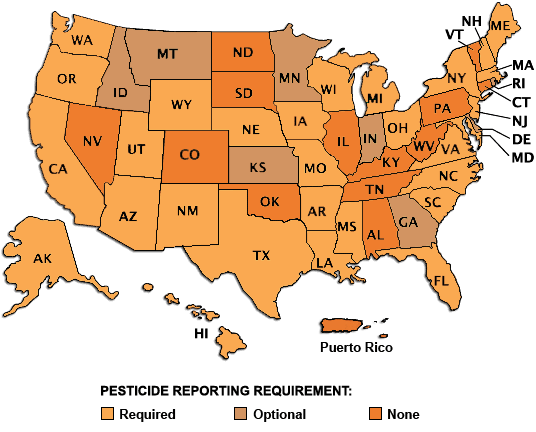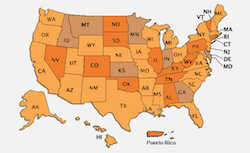- Who We Are
- Clinician Employment
- Publications
- Witness to Witness (W2W)
- Kugel & Zuroweste Health Justice Award
- Your Voice Matters: Photovoice Project
Pesticide Clinics

States
- Washington
- Oregon
- California
- Idaho
- Montana
- Nevada
- Utah
- Arizona
- Wyoming
- North Dakota
- South Dakota
- Colorado
- New Mexico
- Texas
- Nebraska
- Kansas
- Oklahoma
- Minnesota
- Iowa
- Missouri
- Arkansas
- Wisconsin
- Illinois
- Michigan
- Indiana
- Ohio
- Kentucky
- Tennessee
- Louisiana
- Mississippi
- Alabama
- Florida
- Georgia
- South Carolina
- North Carolina
- Virginia
- West Virginia
- Pennsylvania
- Maryland
- Delaware
- New Jersey
- Massachusetts
- Rhode Island
- Connecticut
- New York
- Vermont
- New Hampshire
- Maine
- Alaska
- Hawaii
- Puerto Rico
Territories
Use this interactive map developed by MCN and Farmworker Justice to determine the pesticide reporting regulations in your state and where and how to report. Use it to find state workers' compensation requirements and restrictions in agriculture as well as information about workers' compensation. Pesticide reporting requirements and workers' compensation for farmworkers and agricultural workers varies from state to state.
Pesticide incident reports are extremely valuable to state and federal regulators, allowing them to spot trends and identify practices or products that are particularly hazardous. These trends alert regulators of the need to improve protections for farmworkers such as instances where a required restricted entry interval (REI), is not long enough to protect field workers.
Clinicians have a role in creating safer workplaces and informing policy decisions. These cases demonstrate how reporting has lead to stricter regulations and greater protection for farmworkers:
- In May 1986, 198 farmworkers were sent to pick oranges only seven days after the groves had been sprayed with propargite (Omite-CR). Fifty-two percent of the workers (114) sustained severe chemical burns. Upon investigation, it was learned that the manufacturer's addition of a new inert ingredient to the formulation allowed the active ingredient to remain on the leaves for 42 days. This change also caused the product to be toxic to workers for that same extended time period. California subsequently banned Omite-CR for any agricultural use. (Saunders LD, Ames RG, Knaak JB, et al: Outbreak of Omite-CR- induced dermatitis among orange pickers in Tulare County, California. J Occup Med 29(5):409-413, 1987.)
- In the summer of 1993, physicians in Washington State filed 26 reports with their state department of health of phosdrin poisoning among farmworkers who had been applying the insecticide in 19 separate apple orchards. Alerted to this rash of poisonings, the Centers for Disease Control and Prevention investigated and determined that at least one-third of the poisoned workers had fully complied with all label instructions for protecting themselves from exposure. Largely due to these findings, the EPA banned the use of phosdrin in 1995. (Centers for Disease Control and Prevention: Occupational pesticide poisoning in apple orchards-Washington, 1993. MMWR 42(51-52): 993-995, 1994).
- In early 2010, two fruit quality inspectors sought care for similar symptoms after assessing Chilean grape imports. Upon arrival to the U.S., grapes are required to be treated with the fumigant methyl bromide (MeBr). The inspectors visited their physicians for neurological symptoms such as dizziness, memory troubles, and difficulty walking. Medical evaluations confirmed they had MeBr poisoning. In response, California cold storage facilities installed methyl bromide monitoring devices and implemented various exposure control protocols such as ventilation, work hour restrictions, and pre-purging of trailers before off-loading. Workers were educated on the situation through training and posting. (California Environmental Protection Agency: Summary of results from the California pesticide illness surveillance program. 2013)




